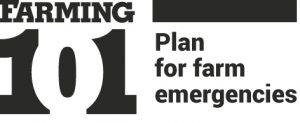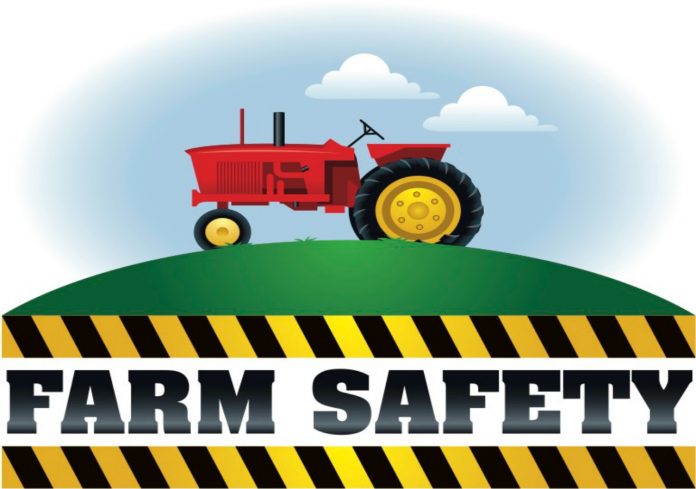Farm accidents and emergencies can happen anytime. Preplanning is an important step of farm safety. Plans should include instructions on what to do in case of an emergency, maps, inventory lists and emergency numbers.

1Make a plan
Sit down with family members and farm workers and make a list of things that need to be in done if an emergency should arise.
2Emergency information
An emergency response plan should include a list of telephone numbers in order of who to call. The list should also include the owner’s home and other farm telephone or cell numbers, names and numbers of local chemical dealers and emergency response personnel. Keep this list near all phones or main work stations on the farm.
3Emergency calls
When calling for help, rescue workers need to know:
- The location of the accident and directions to the location.
- The telephone number from which the call was made.
- The nature of the accident. (I.e. tractor rollover, PTO injury, etc.)
- The number of victims.
- The condition of the victims. (Breathing, bleeding, etc.)
- Type of first aid given, if any. (CPR, etc.)
- Whether someone will meet them at the entrance to direct them to the victim.
- Any special conditions in the area that will interfere with rescue efforts. (Muddy fields, etc.)
- Any other necessary information.
4Notification system
It is important for people with whom you are working to know where you are. Tell someone where you will be working for a certain amount of time. Keep bulletin boards in the farm office with time, date, and the location of where you will be working. Keep in touch with cell phones.
If you do not report back after a certain time, other workers will know where to look for you.
5Farm maps
Many roads and rural areas do not have signs or are known by other names. Rescue personnel need to know the names of roads in the area and their location.
Make a map of the fields on your farm and the access roads with their proper names. Keep a copy of the map in your office and home, give a copy to local rescue, and post near phones.
A facility map should show all buildings, fixed equipment and utility shut-off points. Put a distance scale and compass on the map. Label and name buildings and note their contents, such as chemical or equipment storage. Show loading tanks, fixed equipment, wells and sewer lines.
6Inventory lists
Emergency response plans should include an inventory list. The list should include quantities and locations of pesticides, first aid kits, tools, fire extinguishers, protective clothing, shovels, disposal containers and absorbent material.
7Dealing with the media
The media will report on major farm accidents and disasters and will need the most accurate and timely information. Designate one person to talk to the media and prepare that person with information the public needs to know (such as the nature of the emergency, chemicals involved, injuries and potential hazards).
Spokespersons should not speculate, lie or say “no comment.” They should give a reason why they can’t respond, such as it is unconfirmed information or a legal matter. Being calm, confident and honest will help relieve the public and promote good media relations.
Sources: Preplanning for Farm Emergencies, Maine Farm Safety Program, University of Maine Extension.
(Farm and Dairy is featuring a series of “101” columns throughout the year to help young and beginning farmers master farm living. From finances to management to machinery repair and animal care, farmers do it all.)
More Farming 101 columns:
- 7 keys to success on the farm
- 7 tips for healthy fair animals
- 5 tips to ensure livestock health before the fair
- 6 tips to keep your livestock parasite free
- 6 tips for vaccinating your livestock
- 5 tips to prevent dairy cow foot problems
- 6 common foot problems found in dairy cows
- Recognize, prevent heat stress in dairy cattle
- How to monitor your dairy herd
- How to start your own dairy farm
- 5 tips for sun safety in the field
- Employing youth for the summer
- What to do if a hay fire occurs
- How to prevent hay fires
- How to extend the life of your fence
- 10 safety tips for installing electric fences
- How to chose the right fence for your farm
- How to create a fencing plan
- 7 steps for easy sprayer calibration
- Prepare for planting season, Part 2: Calibration
- Prepare for planting season, Part 1: The Basics
- 7 tips to improve security on your farm
- 5 tips to protect your farmland
- 3 measures to deal with severe farm debt
- How to buy time to catch up on farm debt
- 6 tips to manage income on the farm
- 5 tips to recognize and deal with farm stress
- How to prepare a livestock birthing kit
- 5 tips for marketing your farm
- How to develop farm mission, vision statements
- 5 tips for setting farm goals
- 2 types of livestock insurance policies
- 6 things you need to know about WFRP plans
- 3 basics of crop insurance
- How does liability insurance work on the farm?
- Why do I need farm insurance?
- How to understand and use Ohio’s CAUV
- How to utilize the Pa. Clean and Green Act
- 9 tips for filing farm taxes
- 8 reasons record keeping for taxes is essential
- 5 tips for post-harvest storage
- 7 tips for family meetings on the farm
- 4 tips for balancing your farm and family
- 4 tips for communicating on the family farm
- 4 tips for firing an employee
- 6 tips for keeping good farm help
- 4 tips for recruiting farm labor
- 5 general farm labor laws
- 4 tips for employing minors
- 4 tips for PTO safety
- 5 things young farmers should know about finances
- The farm balance sheet
- 5 items for your farm’s cash flow statement
- Personal and business records: Keep them separate
- What to include in your farm business plan
- How to approach a lender: Tips for getting a farm loan
- How to use microloans to get your farm started
- Saving for the future: 6 tips for young farmers
- How to create a farm safety kit
- 5 tips for child safety on the farm
- 4 tips for transporting livestock
- 5 ways to better understand tractor stability
- 6 farm equipment hacks











